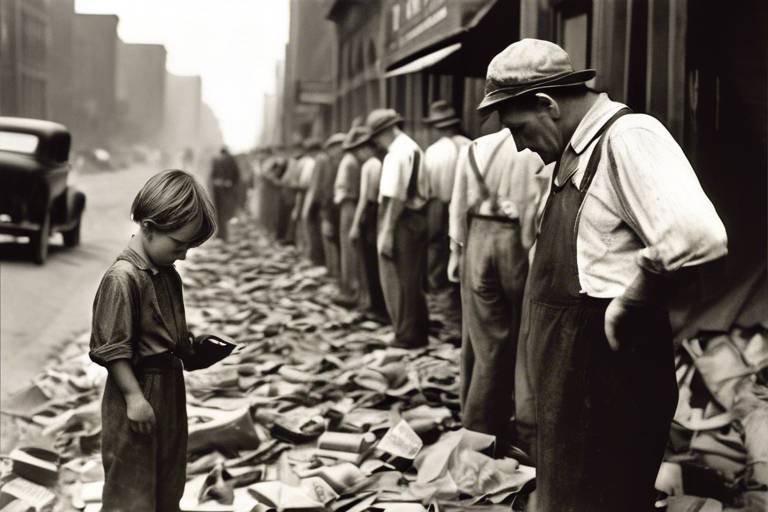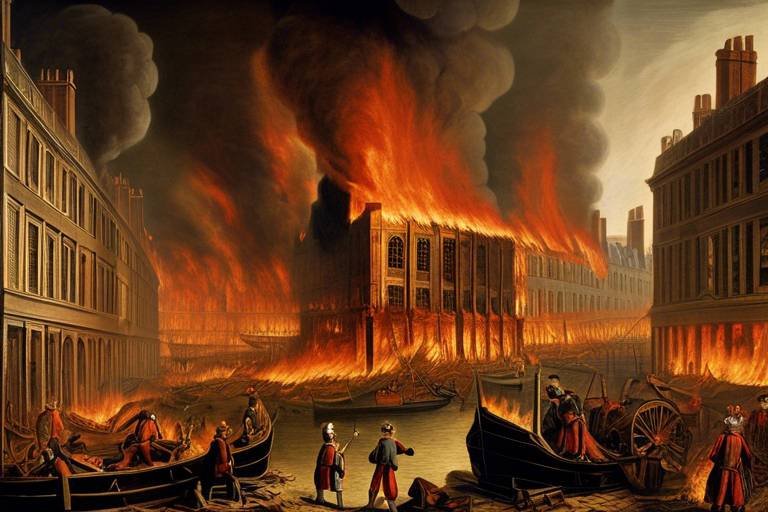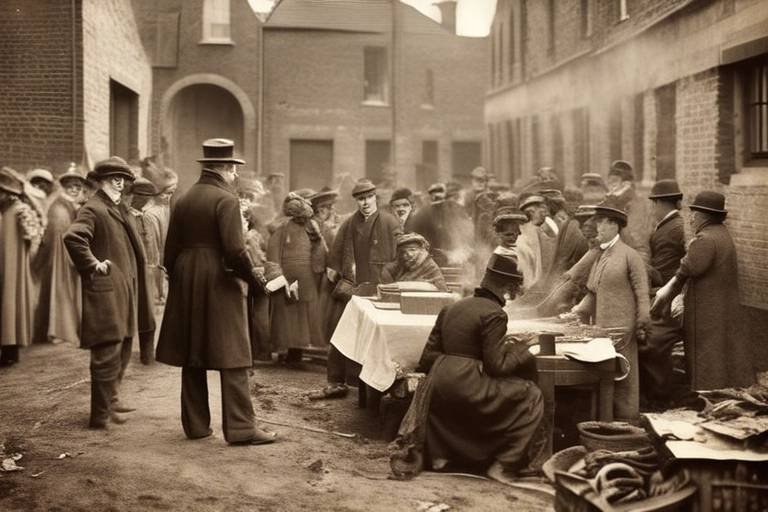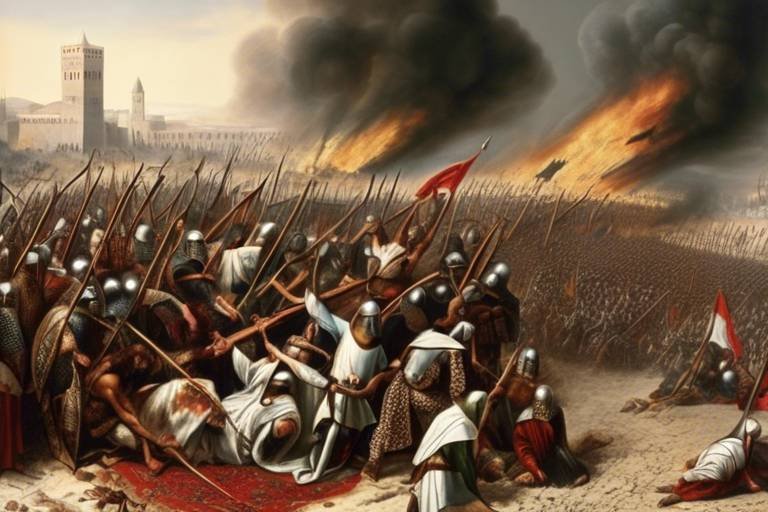The Social and Economic Impact of the Great Depression
The Great Depression, one of the most significant economic downturns in history, had a profound impact on both society and the economy of the United States. During the 1930s, the nation faced widespread unemployment, poverty, and social unrest, leading to a period of immense struggle and hardship for millions of Americans.
As the unemployment rates soared to unprecedented levels, families across the country found themselves grappling with the harsh reality of joblessness. The lack of employment opportunities left many individuals struggling to make ends meet, forcing them to confront the harsh realities of poverty and financial instability.
One of the visible signs of the economic turmoil was the rise of Hoovervilles, makeshift shantytowns that emerged in various cities and towns. Named after President Hoover, these communities symbolized the widespread homelessness and destitution experienced by a significant portion of the population.
The impact of the Great Depression extended beyond economic hardship, affecting the very fabric of families and communities. Families were torn apart as they faced the challenges of providing for their loved ones, with women taking on new roles and responsibilities to support their households.
Amidst the financial crisis, the collapse of banks and financial institutions further deepened the economic woes of the nation. Individuals and businesses alike were devastated by the loss of savings and investments, leading to a profound sense of uncertainty and insecurity.
The environmental disaster known as the Dust Bowl compounded the challenges faced by Americans, particularly those in rural areas. Severe dust storms and agricultural devastation ravaged farmlands, exacerbating the economic hardships of farmers and threatening the nation's food supply.
As people sought refuge in urban areas in search of employment opportunities, cities experienced a surge in population, leading to overcrowding and heightened competition for resources. The migration patterns and urbanization trends reflected the shifting dynamics of society during this tumultuous period.
President Franklin D. Roosevelt's New Deal initiatives marked a turning point in the government's response to the Great Depression. Through a series of programs aimed at providing relief, recovery, and reform, the administration sought to address the pressing needs of the people and stimulate economic recovery.
Despite the challenges and hardships, the Great Depression also sparked a wave of cultural and artistic expression. Literature, music, visual arts, and entertainment industries responded to the social and economic struggles of the era, capturing the resilience and creativity of the human spirit in the face of adversity.

Unemployment Rates Soar
The Great Depression had far-reaching consequences on both society and the economy, leading to widespread unemployment, poverty, and social unrest. This article explores the various ways in which this historical event shaped the lives of people during the 1930s.
During the Great Depression, unemployment rates reached unprecedented levels, leaving millions of people without jobs and struggling to make ends meet. The economic downturn caused businesses to close, leading to massive job losses across various industries. Families were devastated as breadwinners lost their source of income, and the unemployment crisis deepened.
As the unemployment rates soared, individuals faced the harsh reality of financial insecurity and uncertainty about their future. The lack of employment opportunities forced many to rely on government assistance or charitable organizations for basic necessities. The psychological impact of long-term unemployment took a toll on the mental health and well-being of individuals, creating a sense of hopelessness and despair.
Furthermore, the high unemployment rates not only affected individuals but also had ripple effects on communities and the overall economy. Consumer spending plummeted, leading to a decline in demand for goods and services, further exacerbating the economic downturn. The cycle of unemployment and reduced purchasing power contributed to a downward spiral of economic instability.
Despite efforts to create job opportunities through government initiatives, the unemployment crisis persisted, leaving a significant portion of the population without sustainable income. The social fabric of society was strained as families struggled to cope with the financial burdens and uncertainty brought about by widespread job losses.
In conclusion, the soaring unemployment rates during the Great Depression had a profound impact on individuals, families, and the economy as a whole. The challenges faced during this period reshaped the social and economic landscape of the 1930s, leaving a lasting legacy of resilience and recovery.

Rise of Hoovervilles
During the Great Depression, the rise of Hoovervilles marked a poignant symbol of the widespread homelessness and destitution that plagued the nation. These makeshift shantytowns, named after President Hoover, emerged in cities and rural areas as a stark reminder of the economic devastation gripping the country.
Residents of Hoovervilles lived in makeshift shelters constructed from salvaged materials such as cardboard, tar paper, and scrap wood. These communities lacked basic amenities like running water, electricity, and sanitation, forcing inhabitants to endure harsh living conditions and constant uncertainty.
The formation of Hoovervilles highlighted the failure of government and social support systems to adequately address the needs of the homeless and impoverished. As families and individuals sought refuge in these ramshackle settlements, they faced daily challenges of survival, including food scarcity, inadequate healthcare, and limited employment opportunities.
Despite the grim circumstances, Hoovervilles also fostered a sense of community and solidarity among their residents. People banded together to share resources, support one another, and find solace in the midst of adversity. The resilience and resourcefulness displayed in these makeshift neighborhoods underscored the human capacity to endure hardship and find hope in the darkest of times.

Impact on Families
The Great Depression had a profound impact on families across the nation, disrupting the traditional dynamics and roles within households. As the economic crisis deepened, many families found themselves struggling to put food on the table and keep a roof over their heads. The breadwinners, often men, were hit hard by widespread unemployment, leaving families without a stable source of income.
Women, who were typically relegated to domestic roles during this era, were forced to take on new responsibilities to support their families. Many women entered the workforce for the first time, taking on jobs to supplement the family income. This shift in gender roles brought about significant changes in family dynamics and challenged traditional notions of gender norms.
Children also felt the impact of the Great Depression, facing hardships such as malnutrition, lack of access to education, and inadequate healthcare. Families struggled to provide for their children's basic needs, leading to long-term consequences on their health and well-being. The emotional toll of poverty and uncertainty weighed heavily on children, shaping their outlook on life and their future aspirations.
Moreover, the breakdown of family structures due to economic strain and social upheaval was a common phenomenon during the Great Depression. Many families were forced to separate, with members seeking work in different cities or states in search of better opportunities. This fragmentation of families not only weakened the support system but also contributed to feelings of isolation and despair.
Despite the challenges faced by families during this tumultuous time, the Great Depression also fostered a sense of resilience and solidarity within communities. Neighbors banded together to provide mutual support, sharing resources and offering assistance to those in need. Families learned to adapt and persevere in the face of adversity, forging bonds that would endure long after the economic crisis had passed.

Bank Failures and Financial Crisis
The Great Depression had far-reaching consequences on both society and the economy, leading to widespread unemployment, poverty, and social unrest. This article explores the various ways in which this historical event shaped the lives of people during the 1930s.
During the Great Depression, unemployment rates reached unprecedented levels, leaving millions of people without jobs and struggling to make ends meet. This section delves into the causes and effects of this widespread unemployment crisis.
Hoovervilles, makeshift shantytowns named after President Hoover, sprang up across the country as a result of widespread homelessness and poverty. Explore how these communities formed and the challenges faced by their residents.
Families were significantly impacted by the Great Depression, with many struggling to provide basic necessities for their loved ones. This section examines the breakdown of family dynamics, the role of women, and the challenges faced by children during this difficult time.
The collapse of banks and financial institutions exacerbated the economic turmoil of the Great Depression. Learn about the causes of these failures, the effects on individuals and businesses, and the government's response to the crisis.
The Dust Bowl, a period of severe dust storms and agricultural damage, worsened the economic hardship faced by many Americans. Discover how this environmental disaster affected farmers, rural communities, and the nation's food supply.
As people sought opportunities in urban areas, cities faced overcrowding and increased competition for jobs and resources. Explore the migration patterns, urbanization trends, and social changes that occurred as a result of the Great Depression.
President Franklin D. Roosevelt's New Deal introduced a series of programs aimed at providing relief, recovery, and reform during the Great Depression. This section discusses the impact of these initiatives on the economy, society, and government intervention.
The Great Depression inspired a wave of cultural and artistic expression, reflecting the struggles and resilience of the era. Delve into how literature, music, visual arts, and entertainment industries responded to the social and economic challenges of the time.
Stay tuned for answers to common questions about the Great Depression and its impact on society and the economy.

Dust Bowl and Agricultural Devastation
The Dust Bowl, a catastrophic environmental event during the Great Depression, devastated agricultural regions in the United States. This period of intense dust storms and soil erosion primarily affected the Southern Plains, including states like Texas, Oklahoma, Kansas, and Colorado. The combination of severe drought, unsustainable farming practices, and high winds created a perfect storm of agricultural devastation.
The fertile topsoil of the Great Plains was stripped away by the relentless winds, leaving behind barren land that was unable to support crops or livestock. Farmers, already struggling due to economic hardships, faced complete ruin as their livelihoods were destroyed. The Dust Bowl not only led to massive crop failures but also forced many farmers to abandon their land in search of better opportunities elsewhere.
As a result of the Dust Bowl, thousands of families were displaced, becoming environmental refugees in their own country. The social fabric of rural communities was torn apart, with many families losing everything they had worked so hard to build. The agricultural devastation had far-reaching consequences, exacerbating the economic challenges faced by the nation during the Great Depression.
The Dust Bowl also had a significant impact on the environment, leading to long-term ecological damage. The loss of topsoil and vegetation contributed to soil erosion, decreased biodiversity, and altered local climates. The lessons learned from this environmental disaster helped shape future conservation efforts and agricultural practices to prevent similar crises from occurring again.

Migration and Urbanization
During the Great Depression, the phenomenon of migration and urbanization played a significant role in reshaping the social and economic landscape of the United States. As individuals and families sought better opportunities and escape from the harsh conditions of rural areas, cities experienced a surge in population influx. This mass movement of people led to overcrowding in urban centers, intensifying competition for limited job opportunities and resources.
Amidst the economic turmoil, the migration patterns were characterized by a shift from rural to urban areas, as people hoped to find employment and stability in cities. This movement not only impacted the demographics of urban populations but also brought about social changes as diverse groups of individuals converged in search of a better life.
As rural communities struggled to cope with agricultural devastation and poverty, urban centers became hubs of activity and desperation. The influx of migrants posed challenges in terms of housing, sanitation, and social services, putting a strain on already struggling city infrastructures.
The urbanization trend during the Great Depression highlighted the resilience and adaptability of individuals as they navigated through the challenges of a rapidly changing society. Despite the hardships faced in cities, many found ways to survive and rebuild their lives, contributing to the dynamic cultural fabric of urban communities.

New Deal Programs
President Franklin D. Roosevelt's New Deal programs were a series of initiatives introduced to combat the devastating effects of the Great Depression. These programs aimed to provide relief, recovery, and reform to the American people, fundamentally reshaping the role of the government in society. One of the key components of the New Deal was the creation of various agencies and programs designed to address specific aspects of the economic crisis.
One of the most well-known programs of the New Deal was the Civilian Conservation Corps (CCC), which employed young men in conservation projects to provide them with jobs and skills training. The Works Progress Administration (WPA) was another significant program that focused on creating employment opportunities through public works projects, including the construction of roads, bridges, and public buildings.
The Social Security Act, passed in 1935, established a system of social insurance to provide financial assistance to the elderly, unemployed, and disabled. This landmark legislation laid the foundation for the modern welfare state in the United States, offering a safety net for those in need.
Additionally, the New Deal included measures to regulate the banking and financial sectors, such as the creation of the Federal Deposit Insurance Corporation (FDIC) to insure bank deposits and prevent future bank failures. The Securities and Exchange Commission (SEC) was established to oversee the stock market and protect investors from fraud and manipulation.
Overall, the New Deal programs had a profound impact on the economy and society, helping to stabilize the financial system, provide relief to those in need, and stimulate economic growth. While not without controversy, these initiatives represented a significant shift in government policy and paved the way for future social welfare programs in the United States.

Cultural and Artistic Responses
The Great Depression had far-reaching consequences on both society and the economy, leading to widespread unemployment, poverty, and social unrest. This article explores the various ways in which this historical event shaped the lives of people during the 1930s.
During the Great Depression, unemployment rates reached unprecedented levels, leaving millions of people without jobs and struggling to make ends meet. This section delves into the causes and effects of this widespread unemployment crisis.
Hoovervilles, makeshift shantytowns named after President Hoover, sprang up across the country as a result of widespread homelessness and poverty. Explore how these communities formed and the challenges faced by their residents.
Families were significantly impacted by the Great Depression, with many struggling to provide basic necessities for their loved ones. This section examines the breakdown of family dynamics, the role of women, and the challenges faced by children during this difficult time.
The collapse of banks and financial institutions exacerbated the economic turmoil of the Great Depression. Learn about the causes of these failures, the effects on individuals and businesses, and the government's response to the crisis.
The Dust Bowl, a period of severe dust storms and agricultural damage, worsened the economic hardship faced by many Americans. Discover how this environmental disaster affected farmers, rural communities, and the nation's food supply.
As people sought opportunities in urban areas, cities faced overcrowding and increased competition for jobs and resources. Explore the migration patterns, urbanization trends, and social changes that occurred as a result of the Great Depression.
President Franklin D. Roosevelt's New Deal introduced a series of programs aimed at providing relief, recovery, and reform during the Great Depression. This section discusses the impact of these initiatives on the economy, society, and government intervention.
The Great Depression inspired a wave of cultural and artistic expression, reflecting the struggles and resilience of the era. Delve into how literature, music, visual arts, and entertainment industries responded to the social and economic challenges of the time.
Frequently Asked Questions
- What caused the Great Depression?
The Great Depression was primarily caused by a combination of factors, including the stock market crash of 1929, widespread bank failures, overproduction, and high levels of debt. These economic challenges led to a severe downturn in the global economy, triggering a decade-long period of hardship and uncertainty.
- How did the Great Depression impact society?
The Great Depression had a profound impact on society, leading to widespread unemployment, poverty, and social unrest. Families struggled to make ends meet, communities faced homelessness and hunger, and individuals grappled with the challenges of surviving in an economy in crisis. The social fabric of the nation was deeply affected by the hardships of the era.
- What were the New Deal programs?
President Franklin D. Roosevelt's New Deal programs were a series of initiatives aimed at providing relief, recovery, and reform during the Great Depression. These programs included measures to create jobs, regulate the stock market, support farmers, and provide social welfare assistance. The New Deal represented a significant expansion of the federal government's role in addressing economic challenges.


















